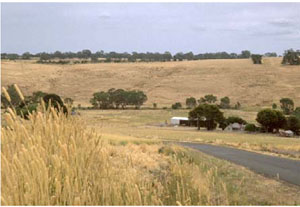LSWW23
Location: Harrow
Australian Soil Classification: Melanic, Black FERROSOL / DERMOSOL (confidence level 4).
General Landscape Description: Rise
Site Description: Hillslope
Geology: Hypatia Formation: flows and plugs of various basalt forms
General Land Unit Description: There are a few isolated outcrops of Jurassic trachyte in the north-western portion of the study area, with the largest outcrop being north east of Coleraine. There are also some colluvial slopes on the edge of trachyte outcrops around the Dundas and Merino Tablelands.
The trachyte hills often have rock outcrop and reasonably shallow soils on the crests and upper slopes. The main soil type on the upper slopes is a Brown Sodosol although Chromosols also occur and they are commonly sodic at depth. The soils on the colluvial slopes tend to be black cracking clays (Vertosols) or Black Vertic Sodosols. These soils are similar to the black soils of the dissected Merino Tablelands land unit. The soils on these slopes are a complex mix of different soil forming processes.
This site is on the steeply dissected hills and rises leading to the Glenelg River and it’s tributaries. Trachyte is often found outcropping through the Tertiary sediments and in association with older sediments and granite. Due to the steep slopes the lower slopes often have an accumulation of colluvial material deposited on top.

Exposed basalt near Harrow
Soil Profile Morphology:
Horizon | Depth (cm) |  | |
| A1 | 0–10 | Very dark grey (2.5Y3/1); light clay; strong medium, parting to strong fine blocky structure; strong consistence, dry; pH 6.5; changes to: | |
| Subsoil | |||
B21 | 10–40 | Very dark grey (10YR3/1); light clay; strong medium polyhedral, parting to strong fine blocky structure; very strong consistence, dry; pH 6.9; changes to: | |
B22 | 40–70 | Very dark grey (10YR3/1); heavy clay; strong angular coarse blocky, parting to strong fine polyhedral structure; very strong consistence when dry; pH 7.3. | |
| B23 | 70–120 | Light olive brown (2.5Y5/3) with many dark grey and yellow brown mottles; heavy clay, strong angular coarse blocky, parting to strong fine polyhedral structure; very strong consistence when dry; pH 7.9. | |
| B24 | 120–175+ | Light olive brown (2.5Y5/3) with many mottles; heavy clay; strong angular coarse blocky, parting to strong fine polyhedral structure; very strong consistence when dry; few ferruginous nodules. |
Soil Profile Characteristics:
- | pH | Salinity |
Surface Soil (A1 horizon) | Slightly Acid | Very Low |
Subsoil (10-40 cm) | Slightly Acid | Very Low |
Deeper Subsoil (70 -120 cm) | Slightly Alkaline | Very Low |
Chemical and Physical Analysis:
Horizon | Horizon Depth (cm) | pH (water) | pH (CaCl2) | EC dS/m | Coarse Sand (0.2-2.0 mm) % | Fine Sand (0.02-0.2 mm) % | Silt (0.002-0.02 mm) % | Clay (<0.002 mm) % | Wilting Point % w/w |
A1 | 0–10 | 6.5 | 5.7 | 0.08 | 6.4 | 12.5 | 20 | 52.5 | 15.9 |
B21 | 10–40 | 6.9 | 5.7 | <0.05 | 4.9 | 10.6 | 18.5 | 61 | 17.5 |
B22 | 40–70 | 7.3 | 6.1 | <0.05 | 5.4 | 9.5 | 14.5 | 65 | 18.5 |
B23 | 70–120 | 7.9 | 6.9 | <0.05 | |||||
B24 | 120–175+ |
Management Considerations:
- Uniform clay soil.
- Strong structure throughout. Could be a self mulching Vertosol. Strong structure and organic matter make it feel lighter
- Slightly acid surface soil grades into neutral to alkaline subsoil
- Mottling in the deeper subsoil.
- Hillslope, well drained site drainage


